Pesticide Storage
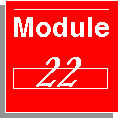
Storage
No job is really finished until the pesticides, containers, and your
equipment have been put away properly. Get into the habit of storing all of your
materials safely before you clean up and go home, or on to the next job. While
you are cleaning up and putting away the pesticides, containers, and equipment
you should wear all the personal protective equipment you used on the job.
Consider wearing gloves and other protective equipment, even if they weren't
recommended on the label. Spills and accidental contamination often occur during
storage procedures.
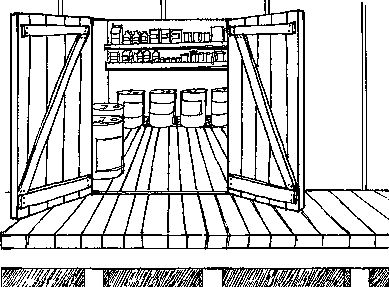
Goals of This Chapter
- Learn how to choose and arrange a storage area for pesticides.
- Understand the importance of handling, storing, and disposing of pesticides
properly.
- Learn what to do in case of a pesticide spill.
The Storage Building
Most applicators use existing buildings or areas within existing buildings for
pesticide storage. However, if you use large amounts of pesticides and/or
equipment, it would be best to build a special storage building just for your
pesticide needs. If possible, use a separate building for your pesticide
storage. If you do not have a separate building, choose a wing or corner on the
first floor of a building.
Before you build a new structure, you should look into suggestions and plans for
pesticide storage put out by state colleges, chemical companies, county
extension agents, etc. When you are setting up any new storage area be sure to
check federal, state, and local regulations on storage areas.
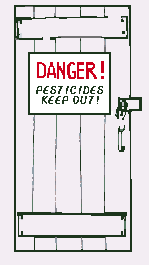
Choosing the Best Site. Whether you choose a site to build a new storage
area or use existing buildings, you need to consider several points. The site
should be in an area where flooding is unlikely. It should be downwind and
downhill from sensitive areas such as houses, ponds, and play areas. There
should be no chance that runoff or drainage from the site could contaminate
surface or groundwater. Sites should be selected so that the soil, geologic, and
hydrologic characteristics will not lead to contamination of any water systems
through runoff or percolation.
 Would you like to try a study question?
Would you like to try a study question?
 Would you like to try a study question?
Would you like to try a study question?
Setting Up the Storage Area. Pesticides should be stored in a cool, dry,
airy room or building which is fireproof. Fans are an important feature of any
pesticide storage building. A properly installed ventilation system should have
a switch outside, so that the fan can be turned on before anyone enters the
facility. The storage area should be fenced in or at least able to be locked
tightly. Weatherproof warning signs should be hung over every door and window.
Pesticides which may be in tank rinsings, spills, seepage from the storage, and
heavy runoff from fire fighting or floods must be controlled. Otherwise, they
may contaminate surface or groundwater. Dikes, collecting pools, and washing
slabs with sumps will provide a proper drainage system and may be required. All
the collected runoff water should be treated as a surplus pesticide and disposed
of properly. A good supply of detergent or soap, hand cleanser, and water is a
must in the storage area. It's convenient for filling tanks, cleaning off
equipment, and for you and your help to clean up with. It's also quick first aid
in a poisoning emergency. Adsorptive clay, activated charcoal, vermiculite, pet
litter, or sawdust should be readily available at the storage site to soak up
spills and leaks. Hydrated lime and high pH commercial detergent should also be
on hand to neutralize the pesticide in an emergency. A shovel, broom, dust pan,
and a fire extinguisher are other "musts" in any storage area.
 Would you like to try a study question?
Would you like to try a study question?
 Would you like to try a study question?
Would you like to try a study question?
 Would you like to try a study question?
Would you like to try a study question?
 Would you like to try a study question?
Would you like to try a study question?
Arranging Your Storage Area
A pesticide storage area, whether it is a room or a whole building, should be
used only for pesticides and pesticide equipment. Never store or use
food, drinks, silverware, tobacco products, or personal protective clothing in
the storage or loading area. Livestock feed, living plants, and seeds should
never be stored with or near pesticides.
 Would you like to try a study question?
Would you like to try a study question?
Avoid Hot Places. Glass and metal containers of liquid pesticides should
be stored where they are not in the sun or near other sources of heat, such as
steam pipes, furnaces, etc. Store pesticides at temperatures above freezing or
as directed on the label. Do not store liquid pesticide in a place where the
temperature can fall below 40 degrees Fahrenheit or go above 100 degrees
Fahrenheit. Protect sensitive pesticides from freezing. Freezing will destroy
the usefulness of some pesticide products. Freezing may also cause liquid
pesticides to break their containers, resulting in leakage. Heat will cause the
liquid to expand so that the contents will be under pressure. Therefore, when
the container is opened the pesticide could splash out on you. No pesticides
should be allowed to become overheated. Some formulations will catch on fire if
they get too hot, while others lose their strength and break down when they are
exposed to heat. Still others will vaporize and become a health hazard.
Special Areas. Herbicides should be stored in a special place apart from
other pesticides, fertilizers, and seeds or bulbs. Some herbicides can vaporize
and get into other pesticides nearby. When the contaminated pesticide is used,
the herbicide vapors in it could injure or kill crops and sensitive plants. All
highly toxic pesticides should be stored together in a special area. Then you
and your helper working in that area can take special precautions to keep from
being exposed. Also, you are less likely to use a highly toxic pesticide by
accident. A special "disposal" area should be used for surplus pesticides and
their containers being held for disposal. They should be grouped together and
plainly labeled according to how you plan to dispose of them. This will help
prevent mix-ups resulting in improper disposal and accidental reuse.
 Would you like to try a study question?
Would you like to try a study question?
Handling Pesticide Containers
Pesticide containers should be stored with the label in plain sight. They should
be stored up off the floor, especially if they can be damaged by dampness. Rigid
containers should always be set in an upright position so they cannot spill. All
containers should be placed in orderly rows with enough room to allow you and
your helpers to walk between them.
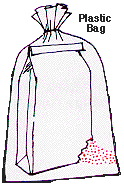
Damaged Containers. All pesticide containers should be checked often for
corrosion, leaks, loose caps, or bungs. You must correct these dangerous
conditions immediately. Pesticides should be stored in their original container
with the label attached. If containers are damaged, however, you should put the
pesticide in a sound and suitable larger container which can be sealed and
labeled. Oftentimes the label from the damaged container can be firmly fastened
to the new container. Paper drums or plastic bags placed within another
container are handy for this purpose. Unlabeled pesticides are dangerous since
you don't know what they are or how to use them. They should be set aside and
held for disposal. Partly empty pesticide containers should be resealed and
returned to storage. Opened containers of chlorates (often used as weed killers)
should not be stored. They can burst into flames at any time.
 Would you like to try a study question?
Would you like to try a study question?
 Would you like to try a study question?
Would you like to try a study question?
 Would you like to try a study question?
Would you like to try a study question?
Improper Containers. Pesticides should be stored in their original
containers, with the label plainly visible and the seal cap securely closed.
Containers should be dated when purchased. Outdated material should be
discarded. To reduce the chances for improper storage, a complete inventory
should be maintained indicating the amount, identity, and date of material
purchased. Pesticides should never be stored in soda bottles, fruit jars, milk
cartons, etc. Storing pesticides in improper containers such as these is a
common cause of pesticide poisoning. Never dump a little of your tank mix in a
jar and give it to someone.
 Would you like to try a study question?
Would you like to try a study question?
 Would you like to try a study question?
Would you like to try a study question?
Pesticide Equipment Storage
All pesticide application equipment should be stored in a special area. The
equipment could be contaminated with pesticides. All items used for handling
pesticides at the storage site, which might be used for other purposes, should
be labeled "contaminated with pesticides" and should not be removed from the
site unless thoroughly decontaminated. Never let children or uninformed people
play on or around your equipment. They could pick up a harmful dose of
pesticide. Do not store pesticides next to food, feed, or other articles
intended for consumption by humans or animals. Always wash your equipment
carefully before you store it. Thoroughly rinse off the outside while it is
parked in the special wash area. Do not allow rinse water to get on the ground
and into streams, ponds, or other sensitive areas. Collect it and hold for
proper disposal. All movable pesticide equipment should have a sign: "Danger . .
Pesticides" to warn people to stay away. Delivery trucks, nurse tanks, and other
support equipment should also be rinsed thoroughly and stored. Materials such as
adsorptive clay, hydrated lime, and high pH commercial detergent should be
available for use as appropriate emergency cleanup agents for spills or leaks.
Keep a shovel, broom, dust pan, absorbant material, container for disposal, and
sprinkler can for decontamination and cleanup of spilled materials.
 Would you like to try a study question?
Would you like to try a study question?
Safety Measures
A little care and common sense can help prevent many accidents and emergencies
in the storage area. You and your helpers should know the basic safety rules and
follow them. You should also know what to do in case of an emergency. Make a
list of safety procedures and post it in the storage area. Be sure that everyone
follows these rules.
Protect Yourself and Others:
- Follow all safety precautions specified on the label and any accompanying label
information.
- Inspect all containers of pesticides for leaks before handling.
- Do not allow children, pets, or uninformed persons into the storage area.
- Wear gloves when you are handling containers of pesticide concentrates. Use more
personal protective equipment if the label says to.
- Do not put your fingers in your mouth or rub your eyes while you are working.
- Do not store or use tobacco, food, or drinks in areas where pesticides are
present.
- Wash your hands carefully before eating, drinking, smoking, or using the toilet.
Wash them as soon as you are finished handling the pesticides.
- Do not handle pesticide containers roughly; they are not meant to be thrown,
dropped, or abused.
 Would you like to try a study question?
Would you like to try a study question?
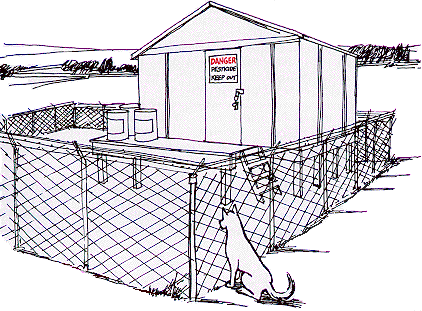
Spills. In spite of all safety precautions, accidents can happen. If a
pesticide spills in your storage area, quick action must be taken. If the
pesticide gets on anyone, wash it off immediately. Have them get out of the
area, wash thoroughly, change clothes, and see a doctor if necessary. Clear the
storage area except for a small clean-up crew. Be sure the crew wears the proper
personal protective equipment. Notify the authorities as described in Chapter
III under SARA Title III, Section 304, Emergency Release Reporting, if the
spilled pesticide is covered by SARA, or by contacting federal, state, or local
pesticide authorities.
If the spill is a liquid, throw activated charcoal, absorptive clay,
vermiculite, pet litter, or sawdust over the entire spill. Use enough to soak up
most of the liquid. Then sweep or shovel it into a large drum. If the spill is a
dust, granular, or powder, sweep or shovel it directly into a large drum.
Sweeping compound can be useful when picking up spills of dry pesticides. Next
cover the spill area with a decontamination agent recommended for that
particular pesticide. The manufacturer or your supplier may have to be
consulted. Hydrated lime and high pH commercial detergents are often
recommended. Repeat this procedure several times. Rinse the whole area with
plenty of water to wash away any remaining poison. Collect the rinse water and
hold it for proper disposal. Check your storage area carefully to see if any
other pesticides were contaminated by the spill. If so, do not take a chance on
using them dispose of them as well. When you are all finished, seal the drum
tightly and store for disposal.
 Would you like to try a study question?
Would you like to try a study question?
 Would you like to try a study question?
Would you like to try a study question?
Fire. Inform your local fire department, hospital, public health
officials, and police of the location of your pesticide storage building. Warn
them of possible hazards and of proper protective clothing to wear in case of
fire. Suggest that they wear air-supplied respirators and chemical resistant
clothing. They should avoid breathing or contacting the smoke or fumes at all
times. If they do contact the smoke and fumes, they should get out of the area
fast and wash off. Post signs around the area and, if possible, give fire
department officials a floor plan of the storage area. Keep all people without
protective gear away from the fire. Anyone who might contact the smoke, fumes,
or contaminated surfaces must be removed from the area. Because it could be
poisonous, all water used in fire fighting should be contained in the storage
area drainage system for safe disposal.
 Would you like to try a study question?
Would you like to try a study question?
Monitoring System. If you store large quantities of pesticides, consider
setting up an environmental monitoring system. Arrange to have samples taken
from water, wildlife, and plants near the storage area. The samples should be
assessed to be sure that no pesticides are getting out into the environment.
Storage Facility Check List
- Separated from offices, workshops, livestock areas
- Separated from wells, streams, lakes, ponds, wildlife
- Separated from food and feed
- Fire resistant building materials
- Impermeable flooring
- Liquid spill containment (berms, 25% of liquid storage)
- Anti-spark electrical components
- Heating system (maintain above 32 degrees F)
- Ventilation system with an outside switch (to vent vapors and maintain at less
than 95 degrees F)
- Locked doors
- Fenced
- Warning signs posted
- Racks for off floor storage
- Emergency eyewash and shower immediately available
- Routine wash-up facilities near by
- Spill kit and fire extinguishers readily available
- Personal protective equipment available
- First aid kit
- Prepared emergency response plan on file
- Pesticide inventory on file
Make it a habit! Store your pesticides and equipment properly before you
clean up and go home, or on to the next job.
Back to Top